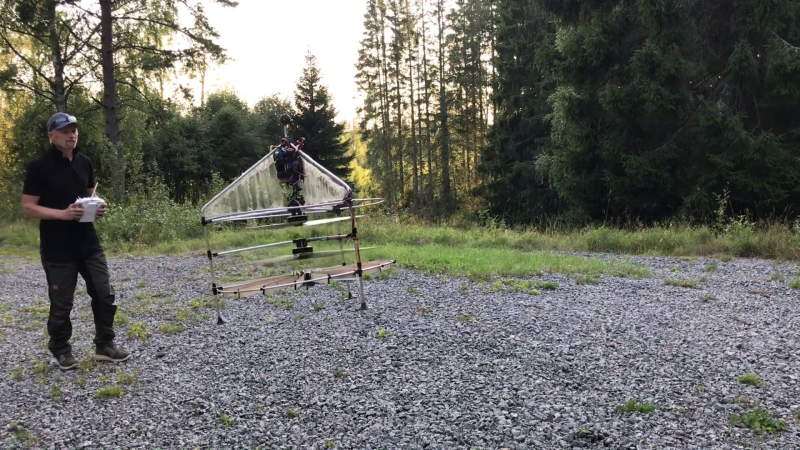One of the major perks of all the affordable flight controllers and motors available from the hobby market is that you can really experiment with some crazy aircraft designs. [amazingdiyprojects] is experimenting with a coaxial helicopter design, with the goal off possibly using for a manned version in the future. (Video link, embedded below.)
The aircraft uses a pair of coaxial counter-rotating motors with large propellers, with several redundant control surfaces below the propellers. One of the theoretical advantages of this arrangement, compared to the more conventional quadcopter type designs, is redundancy. While a quadcopter will start tumbling when a single motor fails, this design will still be able to descend safely with just one motor.
It is also not dependent on the main motors for yaw, pitch and roll control. In multirotors, the motors need to keep a significant amount of the motor’s available power in reserve to increase torque at a moment’s notice for attitude control. This craft can use all the available thrust from the motors for lift, since control is provided by the control surfaces. There are five sets of redundant control surfaces below the propellers, each set connected to a separate flight controller.
Another advantage of this design is efficient for a given footprint, since one large propeller will always be more efficient than multiple smaller propellers. One of the goals for [amazingdiyprojects] is to fit the full size craft in a shipping container or on a trailer for transport without dissasembly.
[amazingdiyprojects] has built manned drones before, using both electric motors and internal combustion engines. And don’t miss the most gonzo wind tunnel ever at 7:00 in the video below.
















The blurb mentions a couple of advantages, but what would be the disadvantages here? There’s always a trade-off with everything, so surely there are some disadvantages with this approach as well.
Tradeoffs with respect to what?
I think the mechanical sophistication needed for the control surfaces is one of the disadvantages. That is certainly why small quad copters are so cheap to make, because sticking a propeller on a motor does not take much sophistication.
One of the problems with this design is it’s inflexibility to cope with big changes in the center of gravity. This design really likes it’s CG dead in the center of the hub. Any shift outside of the center will result in wasting a lot of thrust keeping balance. With other multirotor designs such as quadracopters, this problem can be alleviated by increasing the thrust on one of the motors. On large, fixed wing aircraft, it usually involves adjusting the stab trim before takeoff.
Traditional qauadracopters have stability because they can change the speed of the motors / propellers extremely quickly. This scales badly. It is difficult to get large motors / propellers to change speed quickly = bad stability.
Traditional helicopters solve the problem by having advanced and expensive mechanics for rotating the propeller blades at speed.
Large propellers are a huge victory for efficiency. Co-rotating propellers solve the problem of rotation. The relatively simple rudder solves the problem of flight altitude and balance. The requirements for engine control over the propeller are greatly reduced.
The downside is that stacked propellers lose 30-40% of their efficiency, compared to if they were side by side.
It would be better to have them side by side, but then you have partially recreated the problem with engine control. Or not?
Easier is to pull the cart or push it?
The center of gravity is at the top of drone!
Move batteries down of dorne and all problems will be over.
Does pendulum rocket fallacy apply here? I think it might: as long as the axis of the thrust is rigidly aligned with the center of mass, it does not matter if it is above or below.
If the thrust was at center of mass, sure. The comment was the center of mass was way up at the top. That way, gravity works to topple the ‘copter. With the center of mass below the thrust, the gravity pulls the ‘copter straight up. It’s a huge difference in natural stability.
So you don’t understand the rocket pendulum fallacy either. Neat.
Thrust is not “at at point.” It’s “through a line.” Whether the thrust is applied from under or over CoM doesn’t matter. All that matters is that the vector of thrust passes through the CoM.
Similarly, it doesn’t matter whether a locomotive pushes train cars or pulls then. It provides them with thrust in line with the tracks regardless.
Take the train off of the rails and see what happens when you try to push it. Your analogy does not fit the situation at all. Go read up on Robert Goddard’s attempts at having the CoM below the motor.
Yes it does very much.
Nice work! He understands the flight mechanics very well, that is great to see.
Also his setup for future redundancy is a great.
Saw this guy flying in some mad coffin thing years ago, so will keep an eye out as he obviously has nerves of steel